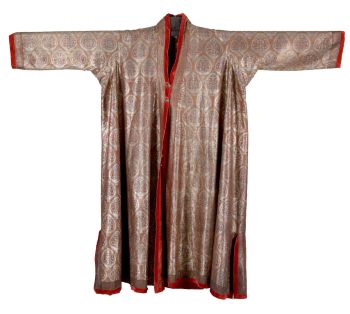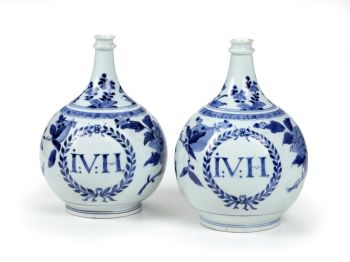Un'importante raccolta di disegni di W.O.J. Nieuwenkamp (1874-1950) 1900
Willem Otto Wijnand Nieuwenkamp
Prezzo su richiesta
Zebregs & Röell - Fine Art - Antiques
- A proposito di opere d'arteAn important collection of drawings by W.O.J. Nieuwenkamp (1874-1950)
From the estate of family of the artist
WILLEM OTTO WIJNAND NIEUWENKAMP (1874-1950)
Nieuwenkamp was born on July 27th 1874 in Amsterdam. His father owned sailing ships sailing to Indonesia and hearing the stories of the returning captains evoked in the young Nieuwenkamp an obsession for distant lands and adventure. After a failed attempt by his father to have his son make a career in his business, Nieuwenkamp attended the Academy for Decorative Art in Amsterdam. However, he left within one year to go his own way.
He was an autodidact and a great experimenter with new techniques, particularly in the art of etching. Nieuwenkamp was a very focused man with the discipline of a scientist tempered by the sensitivity of an artist, a lust for adventure, a natural appreciation for ethnic arts and an enormous ambition to tread new paths.
In 1898 he visited Indonesia for the first time and on his second visit in 1903-1904 he went on to Bali and became the first foreign artist to love Bali and the Balinese with a passion. Having secured agreements with several museums in the Netherlands to obtain Balinese art and objects for their collections, Nieuwenkamp immediately started to purchase and order a wide range of ethnographic art and objects from local artists and craftsmen.
Through his drawings and books, he gave an excellent impression of Balinese art and culture at that time. Since 1854 Northern Bali was under Dutch rule but Southern Bali in 1904, when Nieuwenkamp visited it, was still independent. Nieuwenkamp would be one of the last Westerners to experience a glorious medieval society in its final days. During his second visit to Bali in 1906 the Dutch decided to end the independence of South Bali and Nieuwenkamp was invited by the Governor-General van Heutz to accompany the Dutch invasion force. By contemporary European standards, the Balinese were barbarous and primitive, particularly with widows throwing themselves in the flames of the funeral pyre of their deceased husbands. But Nieuwenkamp was a singular man who saw in their society the beauty and soul that had been lost in his own.
On September 20th, 1906, Denpasar, the capital of South Bali fell to the Dutch military forces. Official military briefings praised the victory which was reported with nationalistic pride on the front pages of all Dutch newspapers. As Nieuwenkamp had witnessed, the truth was far from glorious. As if in trance the Balinese, men women and children, dressed in their finest silks and jewellery and armed with ancient bejewelled krises, the Raja himself mounted atop a golden palanquin, rushed forward, the men killing their wives and children and the Dutch machinegun fire doing the rest. The once-powerful and magnificent court of Denpasar was left in ashes and as many as two thousand Balinese dead. The Dutch suffered four deads.
Nieuwenkamp made drawings and saved as many beautiful architectural elements and artefacts from the rubbles as he could, most of it now in the collection of the Ethnological Museum in Leiden. - A proposito di opere artistaWILLEM OTTO WIJNAND NIEUWENKAMP Nieuwenkamp nacque il 27 luglio 1874 ad Amsterdam. Suo padre possedeva velieri diretti in Indonesia e ascoltare le storie dei capitani di ritorno ha evocato nel giovane Nieuwenkamp un'ossessione per le terre lontane e l'avventura. Dopo un tentativo fallito di suo padre di far fare carriera a suo figlio nella sua attività, Nieuwenkamp ha frequentato l'Accademia di arte decorativa ad Amsterdam. Tuttavia, se ne andò entro un anno per andare per la sua strada. Fu un autodidatta e un grande sperimentatore di nuove tecniche, in particolare nell'arte dell'acquaforte. Nieuwenkamp era un uomo molto concentrato con la disciplina di uno scienziato temperato dalla sensibilità di un artista, una brama di avventura, un naturale apprezzamento per le arti etniche e un'enorme ambizione di percorrere nuove strade. Nel 1898 visitò l'Indonesia per la prima volta e alla sua seconda visita nel 1903-1904 si recò a Bali e divenne il primo artista straniero ad amare Bali e i balinesi con passione. Avendo ottenuto accordi con diversi musei nei Paesi Bassi per ottenere arte e oggetti balinesi per le loro collezioni, Nieuwenkamp iniziò immediatamente ad acquistare e ordinare una vasta gamma di arte e oggetti etnografici da artisti e artigiani locali. Attraverso i suoi disegni e libri, ha dato un'eccellente impressione dell'arte e della cultura balinese in quel momento. Dal 1854 Bali settentrionale era sotto il dominio olandese, ma Bali meridionale nel 1904, quando Nieuwenkamp la visitò, era ancora indipendente. Nieuwenkamp sarebbe stato uno degli ultimi occidentali a sperimentare una gloriosa società medievale nei suoi ultimi giorni. Durante la sua seconda visita a Bali nel 1906, gli olandesi decisero di porre fine all'indipendenza di Bali meridionale e Nieuwenkamp fu invitato dal governatore generale van Heutz ad accompagnare la forza di invasione olandese. Per gli standard europei contemporanei, i balinesi erano barbari e primitivi, in particolare con le vedove che si gettavano tra le fiamme della pira funeraria dei loro mariti defunti. Ma Nieuwenkamp era un uomo singolare che vedeva nella loro società la bellezza e l'anima che si erano perse nella sua. Il 20 settembre 1906, Denpasar, la capitale del sud di Bali, cadde nelle mani delle forze militari olandesi. I briefing militari ufficiali hanno elogiato la vittoria che è stata riportata con orgoglio nazionalista sulle prime pagine di tutti i giornali olandesi. Come Nieuwenkamp aveva visto, la verità era tutt'altro che gloriosa. Come se fossero in trance i balinesi, uomini donne e bambini, vestiti con le loro sete e gioielli più raffinati e armati di antichi kris ingioiellati, il Raja stesso salì su un palanchino d'oro, si precipitò in avanti, gli uomini uccisero mogli e figli e il fuoco di mitragliatrice olandese facendo il resto. La corte un tempo potente e magnifica di Denpasar fu ridotta in cenere e ben duemila balinesi morti. Gli olandesi hanno subito quattro morti. Nieuwenkamp fece dei disegni e salvò dalle macerie quanti più splendidi elementi architettonici e manufatti poté, la maggior parte ora nella collezione del Museo Etnologico di Leida.
Sei interessato ad acquistare questa opera d'arte?
Related artworks
 A cura di
A cura diDanny Bree
1 - 4 / 12


























